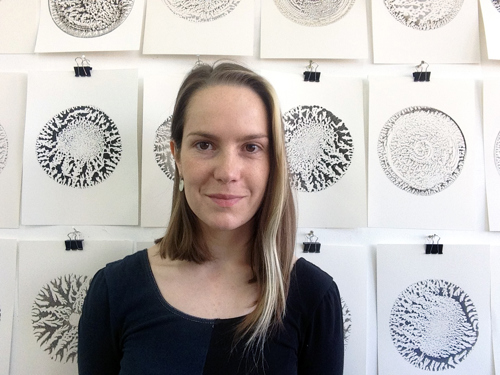Pause carousel
Play carousel
A former Artist in Residence at Abertay University is asking art lovers to question the ethics of eating meat through an exhibition that uses forensic dye to make blood glow bright yellow.
Bea Haines has created installation ‘Acid Yellow 7’ which sees gallery-goers enter a darkened room and use special goggles to view glowing blood spatters across a dining table where a “bloody meal” has been eaten.
The artwork at Science Gallery Melbourne is named after research from Abertay’s Dr Kevin Farrugia, whose work has focused on the use of the substance.
Acid Yellow 7 makes blood glow under a certain wavelength of light and can be used at crime scenes to better visualise hidden blood prints.
In addition to research in this area, Abertay offers a Bsc (Hons) in Forensic Sciences with teaching taking place in the University's new £3.5m science labs.
Bea said: “The installation is an immersive and interactive artwork which depicts a domestic table where a bloody meal has been eaten.
“The items have traces of blood on them, as though a rare steak has been consumed.
“There are also other symbolic and cultural references to blood, such as the wine glasses - in Holy Communion, wine is used as a symbol of Christ’s blood.
“The forensic nature of the artwork combined with the domestic dining setting encourages the viewer to question ethics relating to eating meat.
“Visitors are invited to don goggles and use a specialist torch to reveal the blood traces, which would otherwise be invisible in the dark space.”

Bea created an exhibition including 'invisible art' at Abertay in 2013, using techniques forensic scientists employ to piece together what has happened at the scene of a crime.
Including sculptures, etchings, videos, and digital prints, the showcase also offered an installation in which the viewer played detective, entering a darkened room with a torch and uncovering 'evidence'.
The exhibition was part of the first-ever Print Festival Scotland - a celebration of the cross-disciplinary nature of print.
One of the framed pieces of art was a digital print of magnified fingerprint dust powder, which reveals details not visible to the naked eye.
Bea graduated with an MA in Printmaking from the Royal College of Art in 2010 and has exhibited in solo and group exhibitions, completed residencies at Marlborough College, Abertay University’s forensics lab, Centrespace and Griffin Gallery.
She was listed in Artlyst’s ‘top 10 artists under 30’, was a Print Fellow at the Royal Academy of Arts and winner of the Anthology Art Prize, RBS Bursary award and the Mann and Daler Rowney drawing prizes.
‘Blood’ exhibition at Science Gallery Melbourne runs until September 23 and will come to London in the last week of October.